© 2025, Randy Mosher
Pictured above; The view to the east from the midpoint gondola station on the flank of Mont Blanc above Courmayeur in Valle d’Aosta, Italy.
The Place
If you’re the kind of traveler who loves to catch a selfie at the iconic sights everyone knows about—the Leaning Tower, Sistine Chapel, Michelangelo’s David—there’s precious little in Valle d’Aosta for you.
If, on the other hand, you like diving into uncharted territory to discover your own iconic wonders, this might be your place. It’s not on most peoples’ lifetime list, but this pocket-sized region in Italy’s Northwest is packed with beauty, history, more castles than anywhere else in Europe and a unique mountain gastronomy featuring rich dishes and tasty wines from obscure grapes, often struggling to survive on rocky, high-altitude terraces.
Even a quick glance at a map tells you this ought to be a really beautiful place. Valle d’Aosta is hemmed in on all but the southeast side by many of the biggest mountains in Europe: the Matterhorn, Monte Rosa, Mont Blanc and Gran Paradiso. So everywhere you look, the views are drop-dead gorgeous. A modern tollway runs right up the middle, disappearing into a tunnel under Mont Blanc and exiting in Chamonix, France. Numerous charming small towns dot the region. As part of Savoy, it’s been fought over for centuries, necessitating more than a hundred castles, serving as museums, homes, cultural centers and hospitality operations. We stayed in its capitol, Aosta—a larger town smack in the middle. Founded by the Romans in 26 BCE, it’s just large enough to have a satisfying variety of dining, drinking, shopping and historical attractions in its center, including a brewery. A pedestrian street runs through the oldest part of it. The people were welcoming, and we never felt like part of an invading throng. It’s Italy, but it feels somewhat apart: most place names are in French and there’s a small sub-region that still celebrates its Germanic heritage. The cuisine is a unique product of the mountain environment.
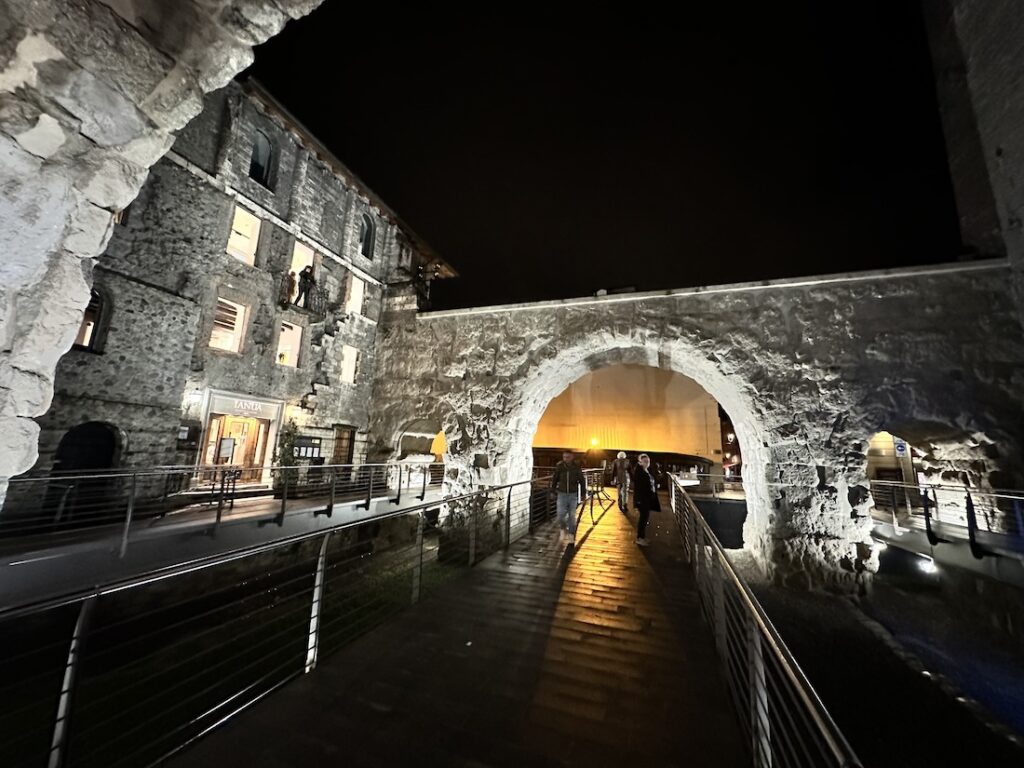

Above, top to bottom, left to right: 1) Roman arches in the pedestrian main drag in Aosta. 2) The stunning alpine meadow at the village of Cogne, at the edge of Gran Paradiso National Park.
Gran Paradiso National Park, named for the peak that dominates it, is in the south. It was Italy’s first national park, originally set aside as a hunting preserve by the Dukes of Savoy, purportedly to protect the ibex, an important symbol of the region. Several charming villages cluster near the park entrance, most notably Cogne, which has a few traditional restaurants and shops. It frames a postcard-perfect view of mountains across an impossibly huge alpine meadow.
Having recently chewed my way through Ian d’Agata’s massive The Native Wine Grapes of Italy, I was intrigued by Valle d’Aosta because of the wines. It is Italy’s smallest wine-producing region. The eastern third is dominated by the amazing Nebbiolo grape, forming the western edge of its production zone which runs through the adjacent Piemonte and Lombardy regions. West of that, there are mostly unfamiliar indigenous varietals whose wines rarely leave the valley, let alone make it across the Atlantic. Some international and other Italian varieties are also grown, especially whites like Pinot Grigio, Moscato and Chardonnay.
Until recently, the decades-long trend in red wines has been jammy, inky, oaky monsters. That’s not what they do here, or really what Italians drink. They have a lot of respect for lighter, fruitier reds, often produced with little or no contact with oak. This makes them much more friendly to everyday fare—or just plain drinking. I may be in the minority, but I think big tannic red wines really need a steak to make any sense.
Going from low to high intensity, Aosta red grapes include Petite Rouge, an ancient mainstay at the heart of a blend called Torette which has been compared in character to a good Beaujolais, the smoky-spicy Cornalin and the spicy/peppery Mayolet, which are often added for character and color in Torette. We had a Mayolet with dinner in Aosta, and found a deep dried-cherry character beneath the spiciness. Fumin is similar to the latter, but perhaps more herbal—sometimes described as “Syrah-like.”Of the native white grapes, the tart and fruity Prié is the star, growing at the west end of the valley at a higher elevation than any other grapes in Europe: 2,600–3,900 feet 800–1,200 m). There, they make a wine from it called Blanc de Morgex (pronounced “mor-JEH”). It is beautifully fruity with a bit of green apple and a refreshing tanginess: perfect foils for rich, cheesy dishes. Both still and sparkling versions are made.
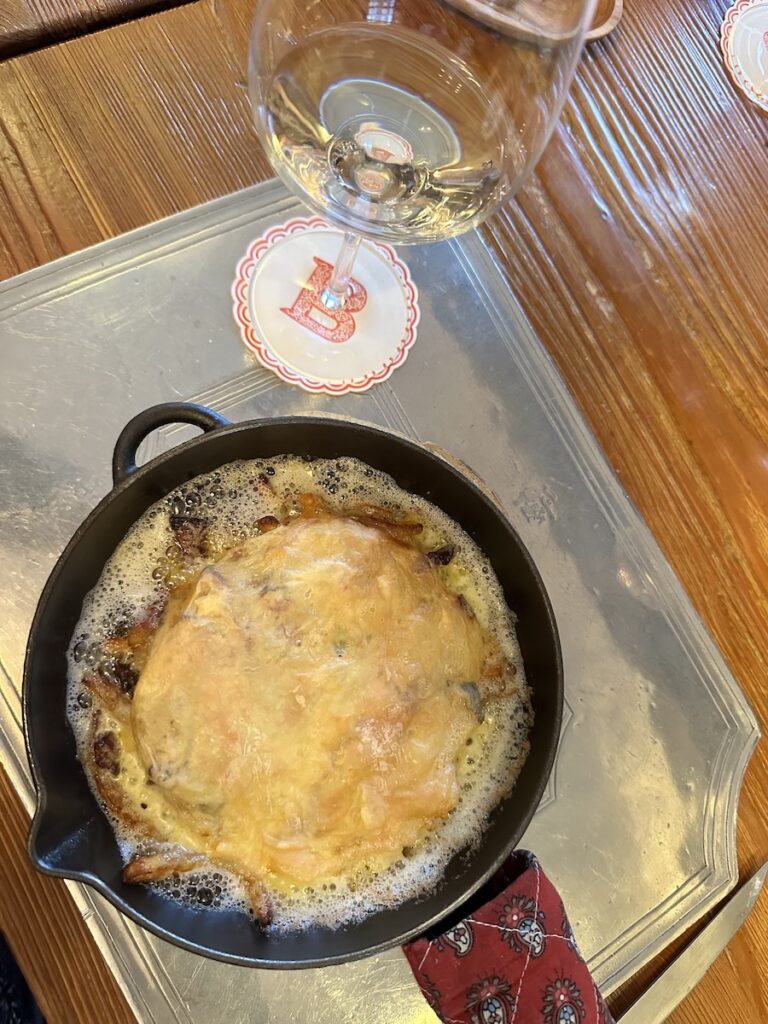
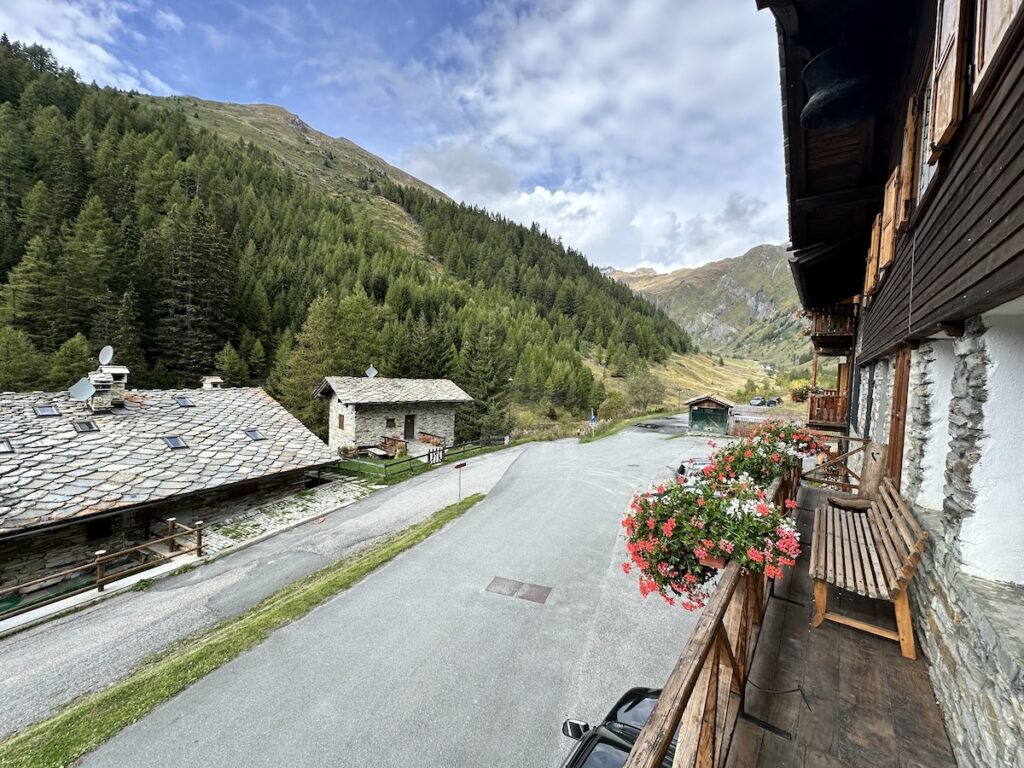
Left: An incredibly rich dish called “tartiflette,” made from potatoes, onions, smoky bacon and loads of melted DOP Fontina cheese. That’s a Blanc de Morgex in the glass: a tangy white wine made from Prié grapes grown at high altitudes. Right: The view uphill from La Jolie Bergere, near Lasalle, in western Valle d’Aosta, where I had the classic seuppa, below.
The Cuisine
If you’re expecting Italian dishes like those you find back home, this will be a huge disappointment. Like many of Italy’s northern regions, Valle d’Aosta nurtures a specialized local cuisine well-adapted to the needs of its denizens and what the landscape can provide. Food really is living history in Italy, but you’re best served by coming at it with few preconceptions and keep yourself open to anything. Yes, you can find pasta in red sauce, but that’s not the attraction. Polenta and potatoes are much more common starches, enlivened by wild mushrooms, cured meats, mountain game and especially local alpine cheese.
Its most legendary cheese, Fontina, is produced artisanally and protected by a DOP (Denominazione Origine Protetta). The real deal bears little resemblance to domestic versions sold in the U.S. under the Fontina name: bland cheeses barely up to the task of piling on a sandwich. Real Fontina is alive and vibrant: matured over time in hefty rounds and washed constantly to maintaining the correct bacterial population for optimal ripening and subtle funk. It melts effortlessly, another reason it’s a staple ingredient in fondue and many other Valdostana dishes. Fortunately DOP Fontina is widely available in the U.S. from stores with a good cheese counter.
In the mountains, soup is always a big deal; it’s calorific, warming and can be conjured up from ingredients that keep well in the pantry, all necessities in this environment. Most famous is seuppa à la Valpellenentse, a close relative of French onion soup made with meat broth over slices of butter-toasted bread and topped with Fontina and broiled. It also contains a bit of cabbage and as I recall, one I had included batons of smoked pancetta (bacon).
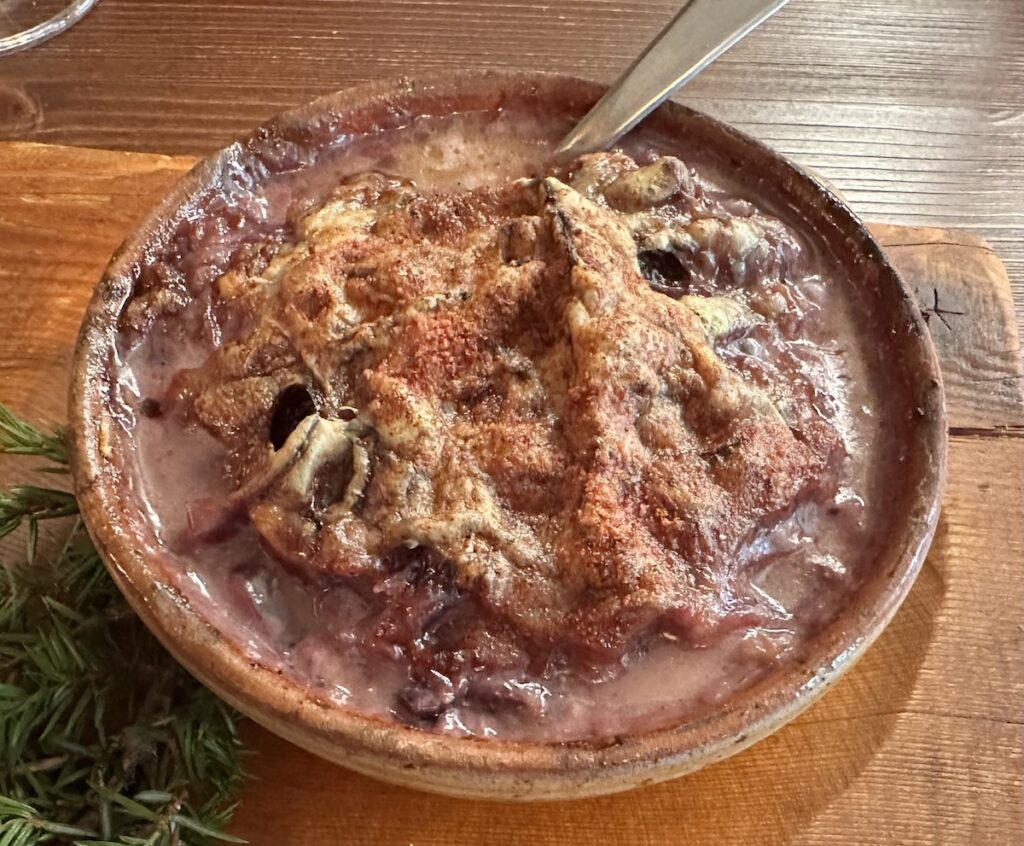
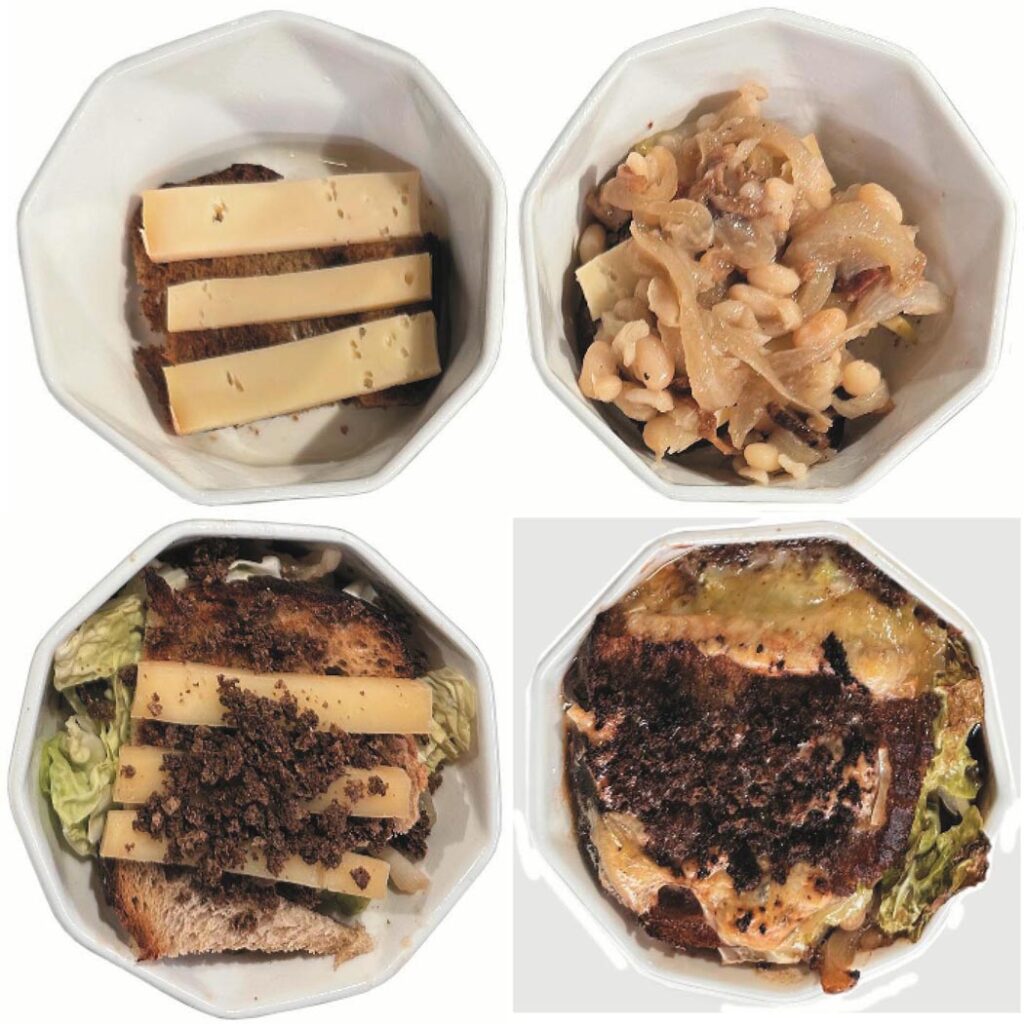

Left: The classic setup-a as served at Le Bon Bec in Cogne, Valle d’Aosta. Right: My homemade version back in Chicago, shown in stages of assembly. Bottom: The ethnobotanical garden on Mont Blanc, at the midpoint station on the gondola.
Here’s an abbreviated recipe adapted from Valle d’Aosta in Cucina, a regional cookbook in French and Italian, by Stefano Torioni.
Brown 8 slices of French bread in clarified butter, and grate a couple ounces of well-dried dark rye bread (no caraway, please). Cut six cabbage leaves into chunks after removing the ribs. Place one slice of bread in each of four ovenproof crocks, adding about half an ounce of DOP Fontina cut into chunky slices. Cover with cabbage, sprinkle with the rye bread crumbs, add another slice of toasted bread and add meat stock to cover; season with a dash of cinnamon. Top each with another half-ounce of Fontina, then convection roast at 350°F/190°C until bubbling and toasty, about 15 minutes. Small batons of smoky bacon in the first layer are optional.Chestnuts are abundant and ubiquitous. We had an appetizer featuring chunked-up roasted chestnuts in a light sweet syrup, served with curls of butter that were to be added, bite-by-bite. It brought our traveling companion, Pam, back to her New England roots where chestnuts were a wintertime treat.
Gastronomic Botany
Just uphill beyond Cogne was Giardino Botanico Alpina Paradiso in Valnontey, home to one of three specialized alpine botanical gardens in the region. Its living collection included yarrow, barberry and several species of wormwood, all used as medicine and in bitter herbal drinks. Another alpine garden (photo above) was at the midway stop on the gondola up Mont Blanc at the western end of Valle d’Aosta. It featured plants adapted to a higher altitude, including the bitter root gentian and more wormwood species including absinthum, or common wormwood famously featured in absinthe and lending its name to the whole family of vermouth (vermut).
What I has hoped to see was missing: génépi, a type of mountain wormwood that stars in an alpine liqueur. The high-altitude plant is rare and threatened; picking is forbidden in Italy, although it is being cultivated in the highlands. It has a mesmerizing aroma that’s best described as shoving your face into evergreen boughs: notes of pine, spruce, rosemary, bay and juniper. The liqueur is fairly straightforward, focusing on the génépi character with subtle side-notes, lightly sweetened to match the modest bitterness. It’s served after dinner as a digestif At Forbidden Root we once made a very tasty saison ale with the herb.
Article and all photos ©2025, Randy Mosher

